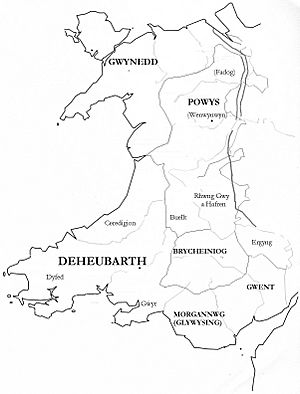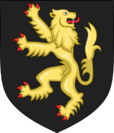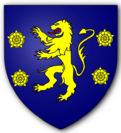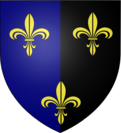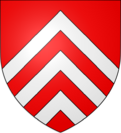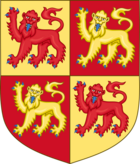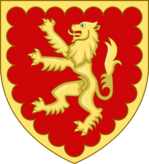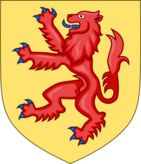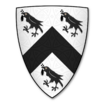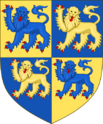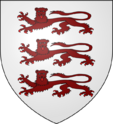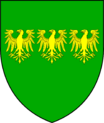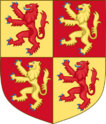List of rulers in Wales facts for kids
This article is about the important leaders and rulers in Wales (called Cymru in Welsh) and nearby areas during the Middle Ages, from about the 400s to the 1500s. These rulers were kings or princes who led their own lands. Some also briefly ruled the whole Principality of Wales. Today, these lands are part of modern Wales and the Welsh Marches in England, both in the United Kingdom.
Before King Edward I conquered Wales in 1282, Wales was made up of many independent kingdoms. The most important ones were Gwynedd, Powys, Deheubarth, and Morgannwg. Because borders often changed, and lands were divided among heirs, very few princes ever ruled all of Wales.
Only one person is known to have ruled all of Wales as a single country: Gruffydd ap Llywelyn. He was a prince of Gwynedd who became King of Wales from 1055 to 1063. Later, between the 13th and 15th centuries, some Welsh princes claimed the title of Prince of Wales. This title is still used today, but it's usually given to the future kings or queens of England and Britain.
Contents
- A Look at Medieval Welsh Kingdoms
- Early Welsh Kingdoms (400s–1000s)
- Welsh Royal Families (870s–1283)
- Welsh Lordships (1000s–1500s)
- Principality of Wales (1216–1542)
- See also
A Look at Medieval Welsh Kingdoms

During the Middle Ages, Wales was a land of many kingdoms and ruling families. Smaller kingdoms like Ceredigion and Gwent started after Britain was no longer part of the Roman Empire, around the late 400s. By the time the Normans invaded Wales in the 1000s, most of these smaller lands had joined together or become part of four main Welsh Kingdoms.
These four major kingdoms were Gwynedd, Powys, Deheubarth, and Morgannwg. Deheubarth was formed later by combining Ceredigion, Dyfed, and Ystrad Tywi. Some smaller kingdoms remained independent but were later taken over by the Anglo-Normans in the 1200s.
One of the last Welsh ruling families came from Powys. This kingdom was divided into Powys Wenwynwyn and Powys Fadog in the 1200s. Later, Owain Glyndŵr became the last Welsh ruler from a royal family in Wales. He rose to power in Powys Fadog in the early 1400s as a Prince of Wales.
Early Welsh Kingdoms (400s–1000s)
Many different kings and princes ruled the various Welsh kingdoms during this time. Here are some of the important ones from the main regions:
Kings of Brycheiniog
- Brychan Brycheiniog ap Anlach (around 400 or 470) was an early ruler.
- Other kings like Tewdwr ap Rhain and Gruffudd ap Nowy followed.
Kings and Princes of Ceredigion
- Ceredig ap Cunedda founded this kingdom around the 5th century.
- Later, Seisyll ap Clydog became King of Seisyllwg, which included Ceredigion.
- Many other rulers, such as Arthen ap Seisyll and Gwgon ap Meurig, led this area.
Kings and Princes of Dyfed
- Early rulers included Triffyn Farfog and Aergol Lawhir.
- Vortiporius was another notable king.
- Later kings like Maredudd ap Tewdwr and Hyfaidd ap Bleddri ruled Dyfed.
Kingdom of Gwynedd
Gwynedd was a very powerful kingdom in North Wales.
Kings of Gwynedd
- Cunedda Wledig ap Edern (around 370) is considered the founder.
- Maelgwn Hir ap Cadwallon (Maelgwn the Tall) was a famous king who died in 547.
- Later kings included Cadwallon ap Cadfan (died 634) and Cadwaladr Fendigaid ap Cadwallon (Cadwaladr the Blessed).
- Merfyn Frych ap Gwriad (died 844) was also a significant ruler.
Princes of Smaller Regions in Gwynedd
- Dogfael ap Cunedda Wledig founded the line of princes in Dogfeiling.
- Dunod ap Cunedda Wledig was an early prince of Dunoding.
- Owain Ddantgwyn ap Einion Yrth was a prince in Rhos.
- Rhufon ap Cunedda Wledig started the line of princes in Rhufoniog.
Kingdom of Morgannwg
This kingdom was in Southeast Wales.
Kings of Ergyng
- Peibio Clafrog ap Erb (around 525) was a king in Ergyng.
- Gwrgan Fawr ap Cynfyn (around 650) also ruled here.
Kings of Glywysing
- Glywys ap Solor (around 430) was an early ruler.
- Later, kings like Ithel ap Morgan and Hywel ap Rhys ruled Glywysing.
Kings of Gwent
- Ynyr Gwent (around 450) was an early king.
- Caradoc ap Ynyr (around 480) and Ffernfael ab Idwal were also kings of Gwent.
- Edwyn ap Gwriad (around 1020) was a later king.
Rulers of Gwynllŵg
- Gwynllyw ap Glywys (around 460) was a ruler in Gwynllwg. His son, Saint Cadoc, also ruled this area.
Kings of Morgannwg (United Kingdom)
The Kingdom of Morgannwg was sometimes formed by joining Morgannwg and Gwent.
- Ithel ab Athrwys ab Meurig (around 650) was an early king.
- Morgan Hen ab Owain (died 974) was a very important king of Morgannwg.
Kingdom of Powys
Powys was a major kingdom in East Wales.
Kings of Powys
- Vortigern (around 365) is a legendary early ruler.
- Cadell Ddyrnllwg (around 430) and Cyngen Glodrydd (around 460) were early kings.
- Brochwel Ysgithrog (around 490) and Selyf ap Cynan (around 550) were also significant.
- Cyngen ap Cadell (died 855) was one of the last independent kings before Powys was linked to Rhodri the Great.
Rhodri Mawr's Descendants
- Merfyn ap Rhodri (died 904) and Llywelyn ap Merfyn (around 870) were descendants who ruled parts of Powys.
Pengwern
- Cynddylan ap Cyndrwyn (active around 642) was a ruler of this smaller kingdom, possibly near modern-day Shropshire in England.
Rulers of All or Parts of Wales
- Gruffydd ap Llywelyn (around 1039–1063) was the only person to rule all of Wales as a single country.
- Rhodri Mawr (Rhodri the Great) ruled Gwynedd, Powys, and Deheubarth from 872 to 878.
- Hywel Dda (Hywel the Good) ruled Dyfed, Gwynedd, Powys, and Seisyllwg, which was almost all of Wales, until his death in 950.
Welsh Royal Families (870s–1283)
The three main royal families of Wales were first set up by Rhodri the Great in the 9th century. Two of his sons started important ruling lines:
- Anarawd ruled in Gwynedd (from Aberffraw).
- Cadell founded Deheubarth (from Dinefwr).
- Another son, Merfyn, ruled in Powys (from Mathrafal).
Aberffraw (Gwynedd)
This was the most powerful royal family, ruling Gwynedd.
Aberffraw Kings of Gwynedd
- Anarawd ap Rhodri (died 916) was the first.
- Idwal Foel ab Anarawd (Idwal the Bald, died 942) was another important king.
- Later, Iago ab Idwal ap Meurig (died 1039) and Dafydd ab Owain Gwynedd (around 1170–1195) also ruled.
Aberffraw Princes of Gwynedd
- Rhodri ab Owain Gwynedd (1175–1195) and Owain Goch ap Gruffydd (Owain the Red, around 1246–1255) were later princes.
Dinefwr (Deheubarth)
The kingdom of Deheubarth was formed by Hywel Dda in 910.
Dinefwr Kings of Deheubarth
- Owain ap Hywel (around 900) was an early king.
- Rhydderch ap Iestyn (died 1033) and Rhys ap Tewdwr (around 1078–1093) were also important kings.
Dinefwr Princes of Deheubarth
- Gruffydd ap Rhys (around 1090–1137) and Rhys Gryg (Rhys the Hoarse, died 1234) were significant princes.
Mathrafal (Powys)
This family ruled Powys.
Mathrafal Princes of Powys
- Iorwerth ap Bleddyn (died 1111) and Cadwgan ap Bleddyn (died 1111) were early princes.
- Madog ap Maredudd (died 1160) was a key ruler.
Mathrafal Princes of Powys Fadog and Powys Wenwynwyn
- Gruffydd Maelor I (died 1191) was a prince of Powys Fadog.
- Owain Cyfeiliog (died 1197) was a prince of Powys Wenwynwyn.
Welsh Lordships (1000s–1500s)
After the Norman invasion around the 1000s, some Welsh areas were ruled by "Lords" instead of kings. These lords were often direct descendants of the old Welsh kings. Some of these lordships lasted even after Edward I conquered Wales in the 1300s, and a few continued into the time of the Principality of Wales.
Lords of Afan
These lords ruled Nedd-Avan in Glamorgan.
- Caradog ap Iestyn (around 1130) and Morgan Gam (died 1241) were important lords here.
Lords of Carleon
These lords ruled Gwynllwg and upper Gwent.
- Gruffydd ap Rhydderch (died 1055) and Caradog ap Gruffydd (died 1081) were key lords.
- Morgan ab Owain (died 1058) was also a Lord of Carleon.
Lords of Ceredigion
- Maelgwn ap Rhys (around 1170–1230) was a significant Lord of Ceredigion.
Lords of Mechain
- Owain Fychan (died 1187) and Llywelyn Fychan (died before 1277) were lords in Mechain, Powys.
Lords of Merioneth
These lords ruled Merioneth, Eifionydd, and Ardudwy, and were descendants of King Owain Gwynedd.
- Cynan ab Owain Gwynedd (died 1174) and Maredudd ap Cynan (died 1212) were notable lords.
- Llywelyn Fawr ap Maredudd and Llywelyn Fychan (father of Madog ap Llywelyn) also ruled Merioneth.
Lords of Nannau
These lords were descendants of Madog ap Cadwgan ap Bleddyn from Powys.
- Madog (around 1118–21) was the first Lord of Nannau.
- Hywel Sele (died 1402), a cousin of Owain Glyndwr, was the 9th Lord.
Lords of Powys Fadog
These lords ruled Northern Powys and belonged to the House of Mathrafal.
- Madog ap Gruffydd Maelor (died 1238) was a major Lord of Powys Fadog.
- Gruffydd Maelor (died 1269) and Madog II ap Gruffydd, Lord of Dinas Bran (died 1277) were also important.
- Gruffudd Fychan II (born 1354), the father of Owain Glyndwr, was Lord of Glyndyfrdwy.
Lords of Powys Wenwynwyn
These lords ruled Southern Powys, also from the House of Mathrafal.
- Gwenwynwyn (died 1216) was a key Lord of Powys Wenwynwyn.
- Gruffydd ap Gwenwynwyn (died 1286) and Owen de la Pole (died 1293) followed him.
Rhwng Gwy a Hafren
This region between the Rivers Wye and Severn was ruled by lords.
- Elystan Glodrydd (around 975) was an early lord.
- Cadwallon ap Madog (died 1179) ruled Maelienydd and Elfael within this region.
Lords of Senghenydd
- Ifor Bach (around 1158) was a famous Lord of Senghenydd.
- Llywelyn Bren (died 1317) was another notable lord here.
Principality of Wales (1216–1542)
The Principality of Wales was a large territory in the late Middle Ages. Welsh royal family members ruled this area or tried to get back their family lands during this time. They were officially called "Prince of Wales" or claimed the title. This area included the old kingdoms of Gwynedd, Deheubarth, and Powys.
Before the Principality (1165–1197)
- Owain Gwynedd ap Gruffydd (around 1137–1170) was King of Gwynedd and was sometimes called Prince of Wales.
- Rhys ap Gruffydd (around 1132–1197), known as The Lord Rhys, was Lord of Deheubarth and also claimed the title Prince of Wales.
Welsh Rule (1216–1283)
- Llywelyn Fawr ap Iorwerth (around 1195–1240) was Prince of Gwynedd and Prince of North Wales. He was a very powerful ruler.
- Dafydd ap Llywelyn (around 1240–1246) was Prince of Gwynedd and claimed the title Prince of Wales.
- Llywelyn ap Gruffudd (around 1246–1282), known as Llywelyn the Last, was the last independent Prince of Wales.
- Dafydd ap Gruffydd (around 1282–1283) was Prince of Gwynedd and also claimed the title Prince of Wales after his brother.
English Rule (1283–1542)
After the English conquest, some Welsh leaders still claimed the title Prince of Wales:
- Madog ap Llywelyn (around 1294) claimed the title during a rebellion.
- Owain ap Tomas ap Rhodri (around 1372–1378), also known as Owen the Red Hand, claimed the title while living in exile.
- Owain ap Gruffudd (around 1400–1415) led a major Welsh rebellion and was proclaimed Prince of Wales.
See also
- Family tree of Welsh monarchs
- Kings of the Britons
- Fifteen Tribes of Wales
- Prince of Wales


